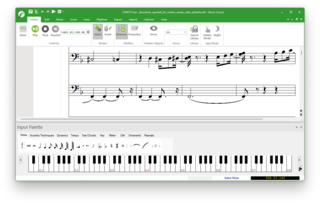Sheet music is a handwritten or printed form of musical notation that uses musical symbols to indicate the pitches, rhythms, or chords of a song or instrumental musical piece. Like its analogs – printed books or pamphlets in English, Arabic, or other languages – the medium of sheet music typically is paper. However, access to musical notation since the 1980s has included the presentation of musical notation on computer screens and the development of scorewriter computer programs that can notate a song or piece electronically, and, in some cases, "play back" the notated music using a synthesizer or virtual instruments.

Sibelius is a scorewriter program developed and released by Sibelius Software Limited. Beyond creating, editing and printing music scores, it can also play the music back using sampled or synthesised sounds. It produces printed scores, and can also publish them via the Internet for others to access. Less advanced versions of Sibelius at lower prices have been released, as have various add-ons for the software.
Finale is a proprietary music notation software developed and released by MakeMusic for Microsoft Windows and macOS since 1988. In general, the operation of Finale bears some surface similarities to Adobe Photoshop.
A scorewriter, or music notation program is software for creating, editing and printing sheet music. A scorewriter is to music notation what a word processor is to text, in that they typically provide flexible editing and automatic layout, and produce high-quality printed results.

Music engraving is the art of drawing music notation at high quality for the purpose of mechanical reproduction. The term music copying is almost equivalent—though music engraving implies a higher degree of skill and quality, usually for publication. The name of the process originates in plate engraving, a widely used technique dating from the late sixteenth century. The term engraving is now used to refer to any high-quality method of drawing music notation, particularly on a computer or by hand.

Denemo is a scorewriter and music sequencer. Denemo has been under development since 1999.
capella is a musical notation program or scorewriter developed by the German company capella-software AG, running on Microsoft Windows or corresponding emulators in other operating systems, like Wine on Linux and others on Apple Macintosh. Capella requires to be activated after a trial period of 30 days. The publisher writes the name in lower case letters only. The program was initially created by Hartmut Ring, and is now maintained and developed by Bernd Jungmann.
NoteWorthy Composer (NWC) is a proprietary scorewriter application made by NoteWorthy Software. It is a graphical score editor for Microsoft Windows computers. Version 1 of NWC was released in October 1994, and Version 2 in September 2008.

Guitar Pro is a proprietary multitrack editor of guitar and bass tablature and musical scores, possessing a built-in MIDI-editor, a plotter of chords, a player, a metronome and other tools for musicians. It has versions for Windows and macOS and is written by the French company Arobas Music.
Mosaic was a Macintosh scorewriter application for producing music notation, developed by Mark of the Unicorn.

MusEdit is a scorewriter program for Microsoft Windows, developed by Doug Rogers / Yowza software and first launched in 1997. The current version (4.0.3) was released in 2010.

MuseScore refers to a free and open-source music notation program for Windows, macOS, and Linux and its accompanying online score-sharing platform MuseScore.com and freemium mobile score viewer and playback app. It is now part of Muse Group.

Overture is a music notation (scorewriter) program for Windows and Macintosh platforms, published and developed by Sonic Scores. While Overture is primarily a scorewriter program, it also allows editing the score's MIDI audio playback data in the manner of sequencer and digital audio workstation (DAW) software.
This is a comparison of music notation programs.
MusicEase is a WYSIWYG scorewriter created by Gary Rader and produced by MusicEase Software. It enables computers using Microsoft Windows and macOS to produce musical notation and listen to them in MIDI.
MagicScore is a music notation and composition software product for PCs running Microsoft Windows. Versions of the product sell under the names Maestro Composer, Maestro Notation, and Maestro Notation for MS Word. Two free products in the same product line are offered under the names Maestro Performer and Maestro Online.

Forte is a music notation program developed by the German company Lugert Verlag, located in Handorf. Its name is derived from the dynamic marking of forte. The program is available in both German and English.









